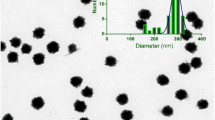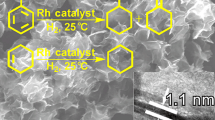Abstract
The catalytic properties of noble metal nanocrystals can be tuned via engineering their structures. Nanocrystals with fractal structures are fascinating catalysts regarding their large surface area-to-volume ratios, large numbers of edges and corners, which can be tuned simultaneously by their hierarchical ordering. However, it is still a great challenge to control the hierarchical ordering of noble metal fractal nanocrystals and their formation mechanism is not fully understood. Herein, we report a facile solvothermal method for the direct preparation of a unique single-crystal Rh-hyperbranched structure, which consists of hierarchically ultrathin nanoplates with threefold symmetry, large surface area and high density of low-coordinated edge/corner sites. Importantly, the hierarchical ordering can be readily tuned by changing the composition of solvent. In addition, we found the as-prepared single-crystal hyperbranched Rh nanoplates possessed great structure stability, and exhibited better catalytic performance towards both ethanol electrooxidation and hydrogenation of styrene than the commercial Rh black, which can be attributed to the large surface area and high-dentisty of edge/corner sites.
摘要
贵金属纳米晶的催化性质与其结构密切相关. 比表面积越大、配位不饱和的边角原子密度越高, 贵金属纳米晶在催化反应过程中表现出的性能往往越优异. 相比于常见的具有完整几何形貌的贵金属纳米晶, 具有多重分级结构特征的超支化贵金属纳米晶拥有更大的比表面积以及更丰富的配位不饱和的活性位点, 因此被认为是一种潜在的性能优异的催化剂. 但这种具有多重分级结构特征的超支化贵金属纳米晶无论是在生长机理研究还是可控制备上都还存在巨大的挑战. 本文通过简单的湿化学法成功制备出一种具有多重分级结构特征的超支化Rh纳米薄片. 该产物由三角形纳米片在扩散限制条件下分级生长形成, 整体呈现三次对称性的单晶特征. 研究表明, 该纳米结构不仅具有出色的结构稳定性, 而且其生长级数可通过反应溶剂比例的简单调节进行调控, 从而实现Rh纳米薄片比表面积和位于边/角活性位点的原子比例的调控. 由于拥有更大的比表面积以及更为丰富的配位不饱和的活性位点, 这种具有多重分级结构的超支化Rh纳米薄片在乙醇电催化氧化和苯乙烯催化加氢催化反应中展现出了比目前主流商业催化剂Rh黑更为优异的催化活性.
Similar content being viewed by others
References
Gu J, Zhang YW, Tao FF. Shape control of bimetallic nanocatalysts through well-designed colloidal chemistry approaches. Chem Soc Rev, 2012, 41: 8050–8065
Jiang ZY, Kuang Q, Xie ZX, et al. Syntheses and properties of micro/nanostructured crystallites with high-energy surfaces. Adv Funct Mater, 2010, 20: 3634–3645
Wu Y, Wang D, Li Y. Understanding of the major reactions in solution synthesis of functional nanomaterials. Sci China Mater, 2016, 59: 938–996
Zhang L, Niu W, Xu G. Synthesis and applications of noble metal nanocrystals with high-energy facets. Nano Today, 2012, 7: 586–605
Jia Y, Cao Z, Chen Q, et al. Synthesis of composition-tunable octahedral Pt-Cu alloy nanocrystals by controlling reduction kinetics of metal precursors. Sci Bull, 2015, 60: 1002–1008
Fu QQ, Li HH, Ma SY, et al. A mixed-solvent route to unique PtAuCu ternary nanotubes templated from Cu nanowires as efficient dual electrocatalysts. Sci China Mater, 2016, 59: 112–121
Chen Q, Jia Y, Xie S, et al. Well-faceted noble-metal nanocrystals with nonconvex polyhedral shapes. Chem Soc Rev, 2016, 45: 3207–3220
Feng Q, Wang W, Cheong WC, et al. Synthesis of palladium and palladium sulfide nanocrystals via thermolysis of a Pd-thiolate cluster. Sci China Mater, 2015, 58: 936–943
Chen X, Shi S, Wei J, et al. Two-dimensional Pd-based nanomaterials for bioapplications. Sci Bull, 2017, 62: 579–588
Wu J, Pan YT, Su D, et al. Ultrathin and stable AgAu alloy nanowires. Sci China Mater, 2015, 58: 595–602
Zhang J, Kuang Q, Jiang Y, et al. Engineering high-energy surfaces of noble metal nanocrystals with enhanced catalytic performances. Nano Today, 2016, 11: 661–677
Haruta M. Size- and support-dependency in the catalysis of gold. Catal Today, 1997, 36: 153–166
Bratlie KM, Lee H, Komvopoulos K, et al. Platinum nanoparticle shape effects on benzene hydrogenation selectivity. Nano Lett, 2007, 7: 3097–3101
Li M, Zhao Z, Cheng T, et al. Ultrafine jagged platinum nanowires enable ultrahigh mass activity for the oxygen reduction reaction. Science, 2016, 354: 1414–1419
Chen C, Kang Y, Huo Z, et al. Highly crystalline multimetallic nanoframes with three-dimensional electrocatalytic surfaces. Science, 2014, 343: 1339–1343
Mandelbrot B. How long is the coast of britain? Statistical selfsimilarity and fractional dimension. Science, 1967, 156: 636–638
Nakayama K, Silverman GH. Serial and parallel processing of visual feature conjunctions. Nature, 1986, 320: 264–265
Witten TA, Cates ME. Tenuous structures from disorderly growth processes. Science, 1986, 232: 1607–1612
Ben-Jacob E, Garik P. The formation of patterns in non-equilibrium growth. Nature, 1990, 343: 523–530
Addison PS. Fractals and Chaos: An Illustrated Course. London: Institute of Physics Publishing, 1997
Chen S, Wang ZL, Ballato J, et al. Monopod, bipod, tripod, and tetrapod gold nanocrystals. J Am Chem Soc, 2003, 125: 16186–16187
Wang S, Xin H. Fractal and dendritic growth of metallic Ag aggregated from different kinds of γ-irradiated solutions. J Phys Chem B, 2000, 104: 5681–5685
Maksimuk S, Teng X, Yang H. Planar tripods of platinum: formation and self-assembly. Phys Chem Chem Phys, 2006, 8: 4660–4663
Chen J, Herricks T, Xia Y. Polyol synthesis of platinum nanostructures: control of morphology through the manipulation of reduction kinetics. Angew Chem Int Ed, 2005, 44: 2589–2592
Ma L, Wang C, Gong M, et al. Control over the branched structures of platinum nanocrystals for electrocatalytic applications. ACS Nano, 2012, 6: 9797–9806
Watt J, Young N, Haigh S, et al. Synthesis and structural characterization of branched palladium nanostructures. Adv Mater, 2009, 21: 2288–2293
Xiao JP, Xie Y, Tang R, et al. Novel ultrasonically assisted templated synthesis of palladium and silver dendritic nanostructures. Adv Mater, 2001, 13: 1887–1891
Shelef M, McCabe RW. Twenty-five years after introduction of automotive catalysts: what next? Catal Today, 2000, 62: 35–50
Chen MS, Cai Y, Yan Z, et al. Highly active surfaces for CO oxidation on Rh, Pd, and Pt. Surf Sci, 2007, 601: 5326–5331
Duan H, Yan N, Yu R, et al. Ultrathin rhodium nanosheets. Nat Commun, 2014, 5: 3093
Yu NF, Tian N, Zhou ZY, et al. Electrochemical synthesis of tetrahexahedral rhodium nanocrystals with extraordinarily high surface energy and high electrocatalytic activity. Angew Chem Int Ed, 2014, 216
Xie S, Liu XY, Xia Y. Shape-controlled syntheses of rhodium nanocrystals for the enhancement of their catalytic properties. Nano Res, 2015, 8: 82–96
Hoefelmeyer JD, Niesz K, Somorjai GA, et al. Radial anisotropic growth of rhodium nanoparticles. Nano Lett, 2005, 5: 435–438
Zettsu N, McLellan JM, Wiley B, et al. Synthesis, stability, and surface plasmonic properties of rhodium multipods, and their use as substrates for surface-enhanced raman scattering. Angew Chem Int Ed, 2006, 45: 1288–1292
Zhang Y, Grass ME, Kuhn JN, et al. Highly selective synthesis of catalytically active monodisperse rhodium nanocubes. J Am Chem Soc, 2008, 130: 5868–5869
Zhang H, Xia X, Li W, et al. Facile synthesis of five-fold twinned, starfish-like rhodium nanocrystals by eliminating oxidative etching with a chloride-free precursor. Angew Chim Int Ed, 2010, 49: 5296–5300
Biacchi AJ, Schaak RE. The solvent matters: kinetic versus thermodynamic shape control in the polyol synthesis of rhodium nanoparticles. ACS Nano, 2011, 5: 8089–8099
Zhang H, Li W, Jin M, et al. Controlling the morphology of rhodium nanocrystals by manipulating the growth kinetics with a syringe pump. Nano Lett, 2011, 11: 898–903
Xie S, Zhang H, Lu N, et al. Synthesis of rhodium concave tetrahedrons by collectively manipulating the reduction kinetics, facetselective capping, and surface diffusion. Nano Lett, 2013, 13: 6262–6268
Huang X, Zhao Z, Chen Y, et al. High density catalytic hot spots in ultrafine wavy nanowires. Nano Lett, 2014, 14: 3887–3894
Zhang SH, Jiang ZY, Xie ZX, et al. Growth of silver nanowires from solutions: a cyclic penta-twinned-crystal growth mechanism. J Phys Chem B, 2005, 109: 9416–9421
Liebovitch LS, Toth T. A fast algorithm to determine fractal dimensions by box counting. Phys Lett A, 1989, 141: 386–390
Lu L, Kobayashi A, Kikkawa Y, et al. Oriented attachment-based assembly of dendritic silver nanostructures at room temperature. J Phys Chem B, 2006, 110: 23234–23241
Fang J, You H, Kong P, et al. Dendritic silver nanostructure growth and evolution in replacement reaction. Cryst Growth Des, 2007, 7: 864–867
Zhang Q, Liu SJ, Yu SH. Recent advances in oriented attachment growth and synthesis of functional materials: concept, evidence, mechanism, and future. J Mater Chem, 2009, 19: 191–207
Witten Jr. TA, Sander LM. Diffusion-limited aggregation, a kinetic critical phenomenon. Phys Rev Lett, 1981, 47: 1400–1403
Witten TA, Sander LM. Diffusion-limited aggregation. Phys Rev B, 1983, 27: 5686–5697
Ming NB, Wang M, Peng RW. Nucleation-limited aggregation in fractal growth. Phys Rev E, 1993, 48: 621–624
Wang M, Liu XY, Strom CS, et al. Fractal aggregations at low driving force with strong anisotropy. Phys Rev Lett, 1998, 80: 3089–3092
Liu XY, Wang M, Li DW, et al. Nucleation-limited aggregation of crystallites in fractal growth. J Cryst Growth, 2000, 208: 687–695
Miller CC. The Stokes-Einstein law for diffusion in solution. Proc R Soc A-Math Phys Eng Sci, 1924, 106: 724–749
Murray CB, Kagan CR, Bawendi MG. Self-organization of CdSe nanocrystallites into three-dimensional quantum dot superlattices. Science, 1995, 270: 1335–1338
Badia A, Singh S, Demers L, et al. Self-assembled monolayers on gold nanoparticles. Chem Eur J, 1996, 2: 359–363
Gebben B, van den Berg HWA, Bargeman D, et al. Intramolecular crosslinking of poly(vinyl alcohol). Polymer, 1985, 26: 1737–1740
Yang Y, Qin H, Jiang M, et al. Entropic ligands for nanocrystals: from unexpected solution properties to outstanding processability. Nano Lett, 2016, 16: 2133–2138
Socrates G. Infrared and Raman Characteristic Group Frequencies: Tables and Charts. Chichester: John Wiley & Sons, 2001
Lim B, Xia Y. Metal nanocrystals with highly branched morphologies. Angew Chem Int Ed, 2011, 50: 76–85
Ye E, Regulacio MD, Zhang SY, et al. Anisotropically branched metal nanostructures. Chem Soc Rev, 2015, 44: 6001–6017
Housmans THM, Koper MTM. CO oxidation on stepped Rh[n(111) × (111)] single crystal electrodes: anion effects on CO surface mobility. Electrochem Commun, 2005, 7: 581–588
Veisz B, Király Z, Tóth L, et al. Catalytic probe of the surface statistics of palladium crystallites deposited on montmorillonite. Chem Mater, 2002, 14: 2882–2888
Király Z, Veisz B, Mastalir Á. CS2 poisoning of size-selective cubooctahedral Pd particles in styrene hydrogenation. Catal Lett, 2004, 95: 57–59
Acknowledgements
This work was supported by the National Basic Research Program of China (2015CB932301), the National Natural Science Foundation of China (21333008, 21671163, 21603178 and J1310024), and China Postdoctoral Science Foundation (2016M602066 and 2017T100468). We particularly appreciate Shilong Liu at the University of Science and Technology of China for the analysis of fractal dimensions.
Author information
Authors and Affiliations
Corresponding authors
Additional information
Author contributions Kuang Q and Xie Z proposed the research direction and guided the whole project. Zhang J designed and performed the experiments and wrote the manuscript; Chen M, Chen J, Li H and Wang S helped draft the manuscript and analyze the data. All authors contributed to the general discussion and reviewed the manuscript.
Conflict of interset The authors declare that they have no conflict of interest.
Supplementary information Experimental details are available in the online version of the paper.
Jiawei Zhang received his BSc degree from Jinan University in 2009. Then he joined the Department of Chemistry at Xiamen University as a graduate and obtained his PhD degree under the supervision of Prof. Zhaoxiong Xie in 2015. He is currently working as a postdoctoral research fellow in Prof. Xie’s group. His research focuses on the controlled synthesis of noble metal nanocrystals, and their applications in catalysis and fuel cells.
Qin Kuang received his BSc degree in 2001 and PhD degree in 2008 from Xiamen University, China. Thereafter, he joined the Department of Chemistry as an assistant professor in Xiamen University and was promoted to associate professor in 2009. His current research focuses on the surface/interface engineering of inorganic functional nanomaterials and their applications in energy and environmental fields.
Zhaoxiong Xie received his BSc degree (1987) in chemistry, MSc degree (1990), and PhD degree (1995) in physical chemistry from Xiamen University, China. He worked as a postdoctoral fellow at the Centre d’Etudes de Saclay in France from 1997 to 1998. Since 2002, he has been a professor of physical chemistry at Xiamen University. His current research is focused on the surface/interface chemistry of inorganic nanomaterials.
Electronic supplementary material
Rights and permissions
About this article
Cite this article
Zhang, J., Chen, M., Chen, J. et al. Synthesis of single-crystal hyperbranched rhodium nanoplates with remarkable catalytic properties. Sci. China Mater. 60, 685–696 (2017). https://doi.org/10.1007/s40843-017-9073-9
Received:
Accepted:
Published:
Issue Date:
DOI: https://doi.org/10.1007/s40843-017-9073-9




